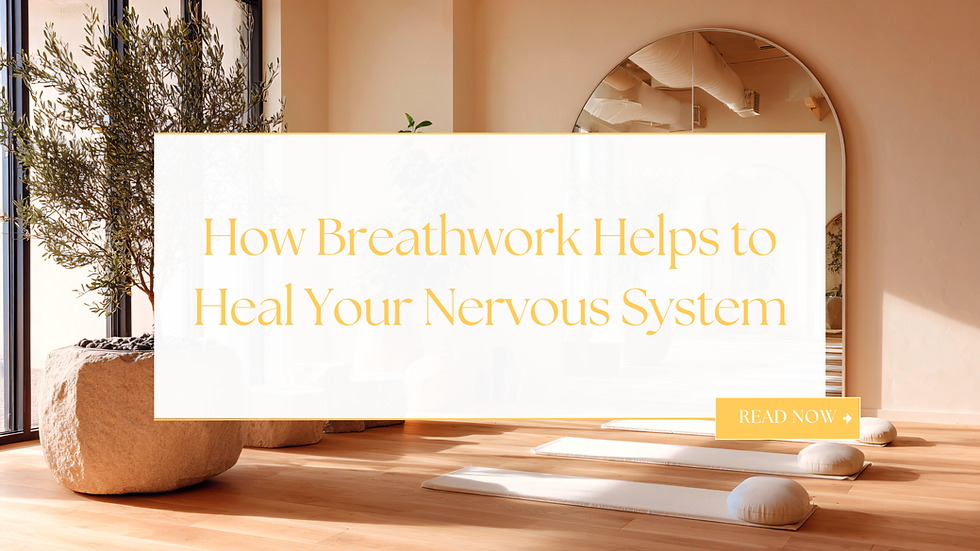How Breathwork Helps To Heal Your Nervous System
- Laura Lee Peters
- Nov 4
- 4 min read
Updated: Nov 5

Most of us, after years of chronic stress, trauma, or people-pleasing, have learned to breathe shallowly — or sometimes we completely forget to breathe until we find ourselves gasping for air. The way we breathe is a reflection of how safe we feel - and for many of us, the very idea of feeling safe and or as if nothing bad is going to happen, is a completely foreign concept.
When you're so used to living on edge, stuck in a constant state of stress, the idea of taking a moment to breathe might feel like just one more thing you have to do.
But when you take the time to breathe, you give your body and your nervous system exactly what it needs to feel - safe.
If we take things one step further and we jump into the world of breathwork, this is where the magic of our breath can help us to experience something truly transformational.
How Breathwork Helps You Release Stored Stress and Trauma

When you begin to breathe consciously — to let your breath flow in a continuous, circular rhythm — something powerful happens. You activate the healing systems that are hard-wired into your brain, body, and nervous system.
Through conscious circular breathwork, you can use your breath as a tool for healing and transformation. You can undo years of compacted nervous system disregulation, release and process trauma, and allow your body and your mind the chance to finally slow down.
There are two main sections during a breathwork session.
Activation
Restoration
During the activation part of a breathwork session, you breathe continuously through your mouth in a circular motion — intentionally increasing oxygen levels while lowering carbon dioxide levels. This activates your sympathetic nervous system (what's often called the “fight-or-flight” mode), but in a safe, intentional way.
Because you’re in control and supported, this activation becomes healing — not harmful. Your body releases adrenaline and shifts brainwave states, allowing stuck energy, emotions, and tension to finally move throughout your body so that it can properly discharge.
From Activation to Restoration

After the activation phase of a breathwork session, you typically move into nasal breathing, which stimulates your parasympathetic nervous system — the part of your nervous system that allows you to rest, digest, and finally soften. This is where your body gets to relax and release so that you can experience a deeper sense of presence and peace within yourself.
Together, these two phases — activation and restoration — show your nervous system how to move fluidly between expansion, release, and rest. Over time, this teaches your body that it’s safe to feel, express, and release, and receive.
What’s Happening in the Brain

When you engage your sympathetic nervous system through breathwork, activity in your neocortex (the analytical, self-protective part of your brain) temporarily quiets down. This opens the doorway to your subconscious mind and emotional memory — the deeper layers where your body holds onto old stories and patterns.
From this space, you can access the parts of yourself that were hidden in order to survive — and you can begin to bring them to the surface with love instead of force.
The Vagus Nerve: Your Body’s Pathway to Peace

Your breath is also one of the most direct ways to stimulate the vagus nerve, which connects your brain to your heart, lungs, and gut. When activated through conscious diaphragmatic breathing, it helps to:
Lower symptoms of chronic stress and anxiety.
Regulate your heart rate and blood pressure.
Support healthy digestion.
Create an internal feeling of safety and peace.
This is why so many people feel grounded, emotional, or deeply peaceful after a session — the vagus nerve is signalling to the entire body, “You’re safe now.”
Healing on Every Level

Breathwork isn’t just about oxygen — it’s about reconnection. In a guided session, breath is often combined with sound, music, and gentle bodywork to deepen the process.
Together, they help you release old emotional armour and reconnect to the parts of you that want to be felt, loved, and expressed.
You begin to trust your body again. You begin to feel again. You begin to come home to yourself.
A Note on Safety
While mouth breathing during guided breathwork sessions is a powerful tool for transformation, your daily breath should always be through your nose.
Nasal breathing helps balance oxygen and carbon dioxide levels, supports your nervous system, and keeps you in a naturally regulated state day to day.
Key Takeaways

Your nervous system isn’t broken — it’s brilliant. It’s been protecting you in the only way it knows how to. But through conscious breathwork, you can remind your body what safety, connection, and freedom actually feel like.
Breath by breath, you can rewrite your story — from survival to safety, from tension to self-trust.
Because when your body feels safe to breathe…you can finally feel safe to be you.
Curious To Try Experience Breathwork for Yourself?
If you're as amazed and excited by the benefits of breathwork as I am, and you'd like to experience them for yourself, stay tuned because once a month me and my beautiful friend Paula Briones, who's a certified breathwork facilitator lead a one of a kind breathwork event which combines breathwork with light language sound healing, and energy medicine.
To learn more about her you can follow her on Instagram @leelabriones
We hope to see you there and we can't wait to hear all about the magic you experience from taking the time to connect to your breath.
Big hugs - Lau <3



Comments